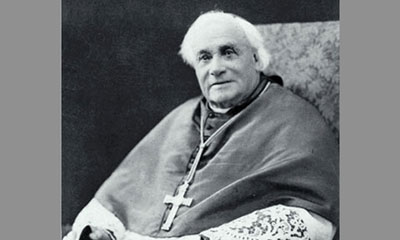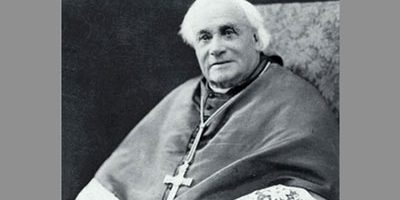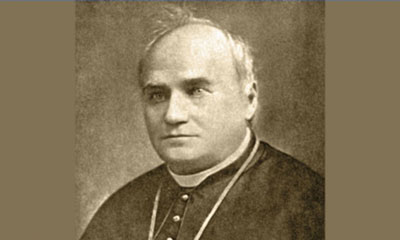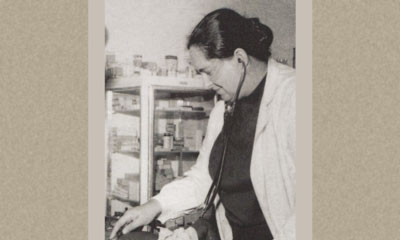November 30, 2018
Cardinal Louis Luçon
Dear Friends,
In 1905, Pope Saint Pius X was considering the bishop of Belley, Bishop Luçon, to succeed Cardinal Langénieux, the archbishop of Reims, who had recently died. The candidate put forth every possible objection, rushing to Rome to explain personally his determination to turn down this great honor. He considered himself incapable of properly bearing so great a responsibility. “Dear Son,” the Holy Father told him forcefully, “it is not just an honor that I am offering you, but a cross, and not only a cross, but a multitude of crosses.” No one had foreseen that Louis Luçon, a shy, scrawny, clumsy child who was often sick, would be elevated to an ecclesiastical post that was as burdensome as it was glorious. Nevertheless, he would bear it for many years, to the honor of Holy Church…
 Louis Luçon was born on October 28, 1842, in Maulévrier, a market town close to Cholet in the wooded countryside of the Vendée. His father was a textile worker. The family lived in poverty on the farm of Chateau Colbert. A pious and studious child, Louis demonstrated a keen intelligence. After the child made his First Communion, his parish priest discerned in him the signs of a vocation. He was enrolled in the municipal school in Cholet, which at that time was run by priests. In spite of his delicate health and a harsh daily routine, he gained a great deal from these school years. In October 1857, he entered the minor seminary in Montgazon (close to Angers). There he completed his courses in rhetoric and philosophy, though not without difficulty, as his studies were interrupted by frequent stays in the infirmary or in the countryside. In 1860, he entered the major seminary in Angers. His spiritual director subjected him to a regimen of meals, walks, and other activities that improved his poor health.
Louis Luçon was born on October 28, 1842, in Maulévrier, a market town close to Cholet in the wooded countryside of the Vendée. His father was a textile worker. The family lived in poverty on the farm of Chateau Colbert. A pious and studious child, Louis demonstrated a keen intelligence. After the child made his First Communion, his parish priest discerned in him the signs of a vocation. He was enrolled in the municipal school in Cholet, which at that time was run by priests. In spite of his delicate health and a harsh daily routine, he gained a great deal from these school years. In October 1857, he entered the minor seminary in Montgazon (close to Angers). There he completed his courses in rhetoric and philosophy, though not without difficulty, as his studies were interrupted by frequent stays in the infirmary or in the countryside. In 1860, he entered the major seminary in Angers. His spiritual director subjected him to a regimen of meals, walks, and other activities that improved his poor health.
Always effective
In 1864, Louis was ordained to the subdiaconate, and appointed private tutor to the son of the viscount of Chabot. He painstakingly devoted himself to his role as educator. Ordained a priest by the bishop of Angers on December 23, 1865, Father Luçon became the vicar of Saint-Lambert-du-Lattay. He strove to live out the ideal of the priest as he understood it, and as he would later characterize it from the pulpit of Notre Dame of Paris, on the occasion of the funeral of Cardinal Richard: “Undoubtedly, the priest must be a man of his time, knowing the errors of his time and refuting them, providing for the needs of his time, remedying the sufferings of his time, making reparation for the injustices of his time. Yes, he must always adapt the methods of his apostolate to the needs of his time…, as we do to ours. But let us not forget that there is one thing which is and must stay the same in all times—his holiness of life… Only holiness can win the priest the confidence of the people—if he does not have it, if he is suspected of not being what he should, neither knowledge, nor modern programs, nor good works will maintain the faithful’s confidence in him. On the contrary, the priest will always owe most of his prestige to holiness.”
In 1869, Bishop Freppel (1827-1891), an Alsatian with a strong personality, was named bishop of Angers. Struck by Father Luçon’s wide knowledge, and the soundness of his judgment, he had him complete a degree in theology (1873), then sent him to Rome to earn a double doctorate in theology and canon law. All too modest, Louis went without enthusiasm. In Rome, his health improved. Bishop Freppel intended for him to teach canon law at the faculty of law that he had just founded. But the humble priest respectfully objected. Angered, the bishop, who allowed only immediate obedience, appointed him parish priest of La Jubaudière, a simple rural church of roughly 700 souls, situated in what had been the “Vendée Militaire”. The parish consisted of a number of small hamlets that were difficult to serve. The spectacular welcome by the residents of La Jubaudière was an encouragement for the parish priest—a crowd of young people on horseback rode out to meet him, bringing him into town, where the mayor and a number of parishioners were waiting to welcome him around a bonfire. “How,” he would later write, “could a priest not love a parish that showed such respect for his character, and such goodwill for his person?” After he became bishop of Belley, he would sing the praises of these Christians, during the consecration of the church in Pin-en-Mauges, a Sanctuary in honor of the martyrs of the Vendée of the Revolution: “The Vendéen loves his religion. It is for him the strongest and even the sole practice of his life. It is the primary, the rock solid foundation of his life. Formed in the harsh school of Father de Montfort, he loves the sublime dogmas of the Catholic faith, the austere morality of the Cross; the sweet consolations of the religion of Jesus Christ go straight to his heart… He loves his priests, and the priesthood is supreme honor that he hopes for his sons. The entire family considers itself honored if one of its members is among the ministers of the altar” (October 13, 1896).
In the sunken lanes
Louis Luçon zealously dedicated himself to serving his parishioners. They would encounter him at night, in the rank sunken lanes, under heavy rain, his soutane raised, advancing in the ruts, to bring the sacraments to the dying. In 1883, the post of pastor in Cholet, the largest parish in the diocese, fell vacant. Bishop Freppel entrusted it to Father Luçon, and to better show him his respect, he came to install him himself. The former pastor had begun to rebuild his church, among other major works. When he arrived, Father Luçon found the finances in a poor state. He was tempted in his discouragement to quit and become a monk, but his concern to worthily fulfill his obligations made him pull himself together. He set to work completing the construction of the church of Our Lady of Cholet. Available to all, he attended the meetings of the many charitable organizations of the parish, discussed decisions, and took an interest in numbers. His cheerful and proper manner commanded respect among his listeners, who could not help but admire the patience and politeness of the new priest. With his exquisite sensitivity and kindness, he succeeded within a matter of months in winning the hearts of his parishioners. He spoke simply, like a father to his children, and in his conversations, his soul became transparent—his candor and spontaneity shone through. During the Cholet textile workers’ strike in 1887, thousands of workers gathered. The priest was called upon, and was able to find the right words to reconcile the quarreling parties, to the benefit of everyone, workers and owners.
That same year, 1887, to thank Bishop Freppel for his service to the government, the Minister of the Interior, Spuller, asked him to choose three candidates for the seat of Belley, then vacant. The parish priest of Cholet was number three on the list, with this comment: “Father Luçon is one of these worthy priests who desires nothing but to remain in the background, although made for more, and whose modesty leads them gladly to say: ‘I am the least in my father’s house.’” Louis Luçon was chosen, as he seemed more tractable to the minister. He was devastated at the news. His confessor urged him to be obedient, and advised him to go see the minister. Spuller, a republican imbued with royal principles, saw enter into his office a young intimidated priest, to whom he elaborated a theory on the rights of the State and the duties of bishops. For a moment, he thought he had brought the priest around to his views. “Your Excellency,” the priest replied, “I have no desire whatsoever for the episcopate, and even have come to Paris only to avoid this honor. If I am forced to accept it, I wish you to know what my course of action will be. To the extent that the rights of the State can be reconciled with those of the Church, I shall show myself, as I must, a good citizen and good Frenchman. But the day that the Church and the State are at odds, I will be on the side of the Church, and I will remain as inflexible as an iron rod.” Displeased, the minister wished to send him away, but Bishop Freppel intervened: “If you do that, they will say that a little parish priest bested a great minister.” Cut to the quick, the minister signed the nomination. On February 8, 1888, the bishop of Angers conferred the height of the priesthood on the child from Maulévrier, in the church of Our Lady of Cholet. Bishop Luçon took as his coat of arms the pascal Lamb, and for his motto: In fide et lenitate (in faith and gentleness).
The true meaning of life
In 1901, to replace the religious teaching congregations that had been abolished by law, Bishop Luçon founded autonomous schools. He also dedicated himself with zeal to preparations for the beatification of the Venerable Curé d’Ars, (the parish of Ars was situated in his diocese). The beatification took place on January 8, 1905. Bishop Luçon often sang the praises of the Blessed. In 1908, he would even return to Belley to do so, when he had already been Archbishop of Reims for two years: “Think back,” he would say, “to the time in which our Blessed carried out his holy ministry in this parish of Ars. One hears endlessly repeated that the present life is all that there is, that belief in a future life is an illusion, that the end of man is pleasure… that the man of today must seek his happiness in science, that science must take the place of religion… With what result? Not knowing the true meaning of life, the men of our time think only of the present life and the goods of the earth… The Curé d’Ars directed disillusioned souls towards the only true good: ‘Outside of God, you see, nothing is solid, nothing, nothing! Life passes, fortunes crumble away, health is destroyed, reputations are attacked. Oh, my God, my God, how pitiable are those who place all their affections in these things!’ And he concluded: ‘Love to serve God, we have but this to do in this world; anything we do apart from this is a waste of time!’”
The role Bishop Luçon played in the beatification of the Curé d’Ars gave Pope Saint Pius X the opportunity to appreciate the prelate. Both were from humble backgrounds, and they practiced the same virtues of selflessness, love of duty, and simplicity. On February 21, 1906, the Holy Father named Bishop Luçon archbishop of Reims, and he asked him to assist him, on February 25, in the ceremony for the consecration of fourteen French bishops whom, given the separation of Church and State, the Supreme Pontiff had appointed without consulting the government. On April 5, the inhabitants of Reims saw their new archbishop arrive, a smile on his lips. His immediate popularity only grew. Nevertheless, the crosses the Pope had predicted soon appeared. Because of the unilateral breaking of the concordat, the Church in France experienced painful trials—the inventorying of ecclesiastical property by civil officials, the expulsion of religious, and political battles. In Reims, the seminarians were thrown out into the street, and Bishop Luçon was expelled from the archdiocese.
Crucified with honors
On December 18, 1907, the archbishop received the cardinal’s hat. When he was congratulated on this, he recalled his modest origins: “The good Lord is crucifying me with honors for which I have neither the taste nor the aptitude. The nails are of gold, but they are nails all the same.” When he appeared in the chair for the first time, it was to the workers he spoke, assuring them that he was one of them by birth and preference. His episcopal home was open to everyone, to the most humble and the most destitute, as well as the most renowned of his diocese. The new cardinal undertook a great deal of activity, organizing the collection of tithes, creating Catholic conferences in the larger parishes, and participating in workers’ celebrations. He defended the Church: “We are depicted as the enemies of the lay schoolteacher, but he was already a lay person, while not so long ago priests and schoolteachers maintained in each of our parishes such cordial relations.” And on the issue of the Church’s right to teach: “We hold this right not from man, but from Jesus Christ, Who has given us the mission to teach all the peoples.”
In August 1914, war broke out. The archbishop placed himself at the disposal of all, especially poor families whose fathers had been called up. After the Pope died on August 20, he went to Rome for the conclave. His heart as a pastor was broken—he would have wished not to leave his diocese in this time of danger. In fact, Reims is very much a symbol for France—it was there that Clovis and his Franks received Baptism, thus giving birth to the French nation; Saint Joan of Arc brought Charles VII there to have him crowned. The invader well understood the city’s symbolic significance, and attacked its most important monument—the cathedral. The cardinal later wrote: “It was the same with me as with the holy man Job. Every day the mail brought me news of a catastrophe worse than the last—Reims was occupied and held for ransom; a hundred hostages had been taken, including two of my vicars general; Reims was bombed, Reims was set ablaze, the cathedral was in flames.”
After a perilous journey, the cardinal finally returned to Reims, which had been liberated following the victory on the Marne on September 22. He would not leave Reims again until the last major German offensive in March 1918. During these four years, he continually walked about the city, comforting victims, visiting schools that had taken refuge underground, religious communities, and ambulances and hospitals, blessing the wounded and the sick. As soon as he would learn that an area had been bombed, he rushed there. Everywhere his presence brought comfort. Sometimes, he had to lie down in the street, or take shelter in a cellar, to avoid shrapnel. Between visits to the city, he remained imperturbable. His coadjutor often found him reading Saint Thomas Aquinas’ Summa Theologica: “Eminence, they’re bombing, we must go down to the cellar.” “Wait, Your Grace, it is nothing but a storm, it will pass.” One night, he miraculously escaped death—a shell fell in the garden and shrapnel flew through his room, missing him by inches. Every week, he walked along the nearby front, visiting the trenches and celebrating Mass there. In his speeches to soldiers, he often returned to the concepts of sacrifice and bloodshed—the price of France’s redemption and salvation. He always stressed the union of religion and fatherland, and the only true consolation there is in the face of death, that given by Providence. “His Grace loves the soldier and the solider adores him,” an officer remarked. “His joy is great when he approaches a group of infantrymen and chats familiarly with them. The soldiers quickly feel at ease with him.”
All alone
Every Friday of the war, the cardinal told his vicars general: “Leave me alone, all alone.” In his cathedral in ruins, open to the four winds, the floor strewn with debris, he made the Stations of the Cross for France. “Forgive them, Lord, forgive Your people. Do not be eternally angered with them. Yes, they have their faults.” Before each station, he read on his knees a medi-tation he had composed.
“When people live in peace with God and one another,” said Pope Benedict XVI, “the earth truly resembles a ‘paradise’. Unfortunately, sin ruins ever anew this divine project, causing division and introducing death into the world. Thus, humanity succumbs to the temptations of the Evil One and wages war against itself. Patches of ‘hell’ are consequently also created in this marvelous ‘garden’ which is the world … I cannot avoid here calling to mind a significant date: 1 August 1917—exactly 90 years ago—on which my venerable Predecessor, Pope Benedict XV, addressed his famous Note to the Heads of Belligerent Peoples, calling for an end to the First World War. While that inhuman conflict was raging, the Pope had the courage to call it a ‘senseless slaughter’. His words are engraved in history. They were justified in the actual situation of that summer of 1917” (Angelus of July 22, 2007).
In spite of the pleas by the Holy See to Kaiser Wilhelm II, the emperor of Germany, to spare the Reims cathedral and churches, they were to experience the Passion. On Palm Sunday, April 1, 1917, and for several weeks afterward, a deluge of bombs rained down on the city. The enemy, who persisted in believing, incorrectly, that the cathedral was being used as an observation post, bombed it incessantly. It was not until April 30 that the mayor of Reims decided to meet with the cardinal. The two men of Reims of opposing views consulted for an hour. “Oh, what a great man he is,” the mayor said, “why did I not see him sooner?” On June 17, 1917, at the request of a deputy, who was the president of the Freethinkers of Reims, the president of the Republic, Raymond Poincaré, decorated the cardinal with the cross of the Legion of Honor, in honor of his patriotism and selflessness. But one decoration touched him even more—that from the 152nd Infantry Regiment, one of the most courageous, which gave him its shoulder braid as well as a certificate of honorary chaplain. On March 25, 1918, the military authorities forced the cardinal, not without difficulty, to leave Reims. “Your Eminence, you are one of the flags of France,” a general told him. “We must save you. We cannot deliver our flag to the approaching enemy.” The cardinal noted in his war journal: “Annunciation. Holy Monday. Last Mass at Reims.”
Fifteen homes unscathed
Reims was liberated in August 1918, but in what a state… Out of the 14,000 homes in the city, only fifteen remained unscathed. The others were destroyed or in need of major repairs. The archbishop’s residence was uninhabitable. After the armistice, Cardinal Luçon dedicated himself above all to restoration of the cathedral. He engaged in fundraising efforts, particularly among Americans. His zeal was unfailing—in the post-war years, he continually watched over his flock. In his pastoral letter of August 15, 1925, he condemned unseemly fashions: “People call for the moral revival of the country. The current fashions were certainly not dreamed up and launched with the aim of contributing to this end. Born of corruption, they are one of the most effective agents of moral depravity. They are, in and of themselves, a provocation to evil, a stimulant to the passions. No one can in good faith maintain that they are harmless… Through sanctifying grace we become temples of the Holy Spirit, through Holy Communion we become living sanctuaries of the divine Eucharist. Does this not require of us dress always worthy of the divine guests who deign to honor us with their visit and their permanent presence? … If there is a place in which immodest fashions and revealing dress are particularly inappropriate, is it not the House of God? Is it not an inexcusable lack of respect, not to mention a defiance or insult to the sanctity of God, to enter His temple, and above all to approach His sacraments in such manifestly immodest attire?”
Although he had the great happiness of returning the cathedral to worship in May 1927, the cardinal would nevertheless not see the end of its restoration. On May 8, 1929, in the presence of the President of the Republic and numerous bishops, he celebrated in Orleans the fifth centenary of the liberation of the city by Saint Joan of Arc, then in Reims, in July, that of the coronation of Charles VII. In May 1930, he fell ill, and died piously on the 28th of that month.
“Consolation comes from Christ alone,” Pope Francis said on September 21, 2014. “Woe to [us] if [we] seek consolation far from the Lord! … [If] you look for consolation anywhere else, you will not be happy! Even more, you will be unable to comfort others, for your own heart is closed to the Lord’s consolation”. The life of Cardinal Luçon is an illustration of this. Let us too draw true consolation from the Heart of Christ, even in the worst difficulties and trials; then we will be able, like Him, to bring peace to hearts that are suffering, and make holy Hope shine in them.







